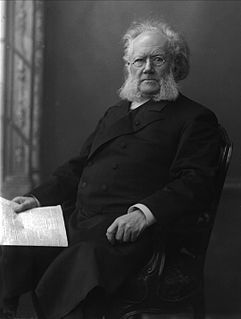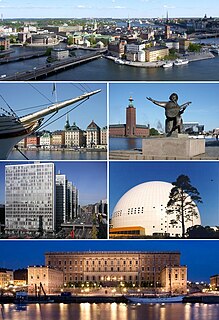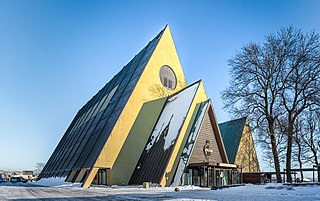
Gustav Vigeland, born as Adolf Gustav Thorsen, was a Norwegian sculptor. Gustav Vigeland occupies a special position among Norwegian sculptors, both in the power of his creative imagination and in his productivity. He is most associated with the Vigeland installation (Vigelandsanlegget) in Frogner Park, Oslo. He was also the designer of the Nobel Peace Prize medal.

Skien[²ʃeːən](listen) is a city and municipality in Telemark county, Norway. It is part of the traditional region of Grenland. The administrative centre of the municipality is the city of Skien. Skien is also the administrative centre of Telemark county.
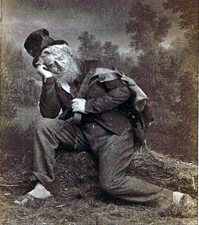
Peer Gynt is a five-act play in verse by the Norwegian dramatist Henrik Ibsen published in 1867. Written in Danish—the common written language of Denmark and Norway in Ibsen's lifetime—it is one of the most widely performed Norwegian plays. Ibsen believed Per Gynt, the Norwegian fairy tale on which the play is loosely based, to be rooted in fact, and several of the characters are modelled after Ibsen's own family, notably his parents Knud Ibsen and Marichen Altenburg. He was also generally inspired by Peter Christen Asbjørnsen's collection of Norwegian fairy tales, published in 1845.

Sigurd Ibsen was a Norwegian author, lawyer and statesman, who served as Prime Minister of Norway in Stockholm (1903–1905) and played a central role in the dissolution of the union between Norway and Sweden in 1905.

Terje Vigen is a poem written by Henrik Ibsen, published in 1862. Much of the story and setting is from the area around the town of Grimstad in southern Norway where Ibsen lived for a few years in his youth. It describes the dramatic saga of Terje who, in 1809, tried to run the British blockade of Norway's southern coast in a small rowboat in a desperate attempt to smuggle food from Denmark back to his starving wife and daughter. He was captured and imprisoned on a British prison hulk and released in 1814 after the Napoleonic Wars were over, only to find that his family had died. He became a pilot, and years later rescued an English lord who turned out to be the commander of the ship that had captured him. The denouement, as in most Ibsen works, should be understood by reading the original.

Christopher Tostrup Paus, Count of Paus, usually known as Christopher Paus and also known as Christopher de Paus, was a Norwegian land owner, heir to the timber giant Tostrup & Mathiesen, papal chamberlain and count, known as philanthropist, art collector and socialite in the late 19th and early 20th centuries. He gave large donations to museums in Scandinavia and to the Catholic Church. In the Acta Apostolicae Sedis and the Annuario Pontificio, his name is spelled (conte) Cristoforo de Paus.
Catiline or Catilina was Henrik Ibsen's first play. It was written during winter 1848–49 and first performed under Ibsen's name on 3 December 1881 at the Nya Teatern, Stockholm, Sweden. The first performance of Catilina in Norway not under Ibsen's pseudonym was at Det Nye Teater in Oslo on 24 August 1935.

Christiania Theatre, or Kristiania Theatre, was Norway's finest stage for the spoken drama from October 4, 1836 to September 1, 1899. It was located at Bankplassen by the Akershus Fortress in central Christiania, in Norway. It was the first lasting public theatre in Norway and the national stage of Norway and of Oslo during the 19th century.
Anna Gutto, or Anna Guttormsgaard is a Norwegian director, artistic director and actress living in New York and Oslo. Her career includes acting, writing, translating, directing and adaptations into English from Norwegian texts.
Elisenberg Station is an unfinished railway station within the Oslo Tunnel on the Drammen Line in Oslo, Norway. The ghost station was partially built during the construction of the tunnel between 1971 and 1980, but has never been put into use. It is located between Nationaltheatret Station and Skøyen Station, at Elisenberg in Frogner. A 220-meter (720 ft) long center platform and part of the access way has been built, but never completed. While the station initially was not put into use because of lack of funds to complete it, it is now unlikely that it will ever be completed, as the need for a station has disappeared and an opening would need a large investment of funds.
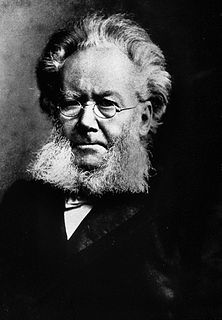
The Ibsen Museum (Ibsenmuseet) occupies the last home of the playwright Henrik Ibsen. It is located close to the Royal Palace on Henrik Ibsens gate in Oslo, Norway.
Laila Elin Goody is a Norwegian actress.
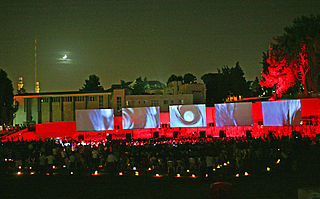
id - Identity of the Soul is a work of performance art produced by Martine Rød and directed by Thomas Hoegh. The first version of this work, Terje, was performed in Yokohama, Japan in 2006 with Paal Ritter Schjerven as Co-Director and Director of Cinematography. and the latest version premiered in Palestine in 2008. In 2009 the show then toured to Doha, Qatar in May and to the Teater Ibsen in Skien, Norway in June. The Studio version of id had its English premiere at the Cambridge Film Festival on 17 September 2009 and is currently touring the UK.
Kjell-Ole Haune is a composer and producer.
Merkantilt biografisk leksikon: hvem er hvem i næringslivet? was a Norwegian-language encyclopedia published by Yrkesforlaget in 1935.
Asbjørn Aarseth was a Norwegian literary historian, born in Inderøy.
Nora Bergliot Ibsen is a Norwegian theatrical producer, noted for being the producer of the 2006 Ibsen Year, Norway's major anniversary of playwright Henrik Ibsen's death 100 years earlier, including high profile celebrations in multiple countries. The Ibsen Year was one of the Norwegian government's major cultural undertakings in 2006, aimed at increasing appreciation of Henrik Ibsen and Norwegian culture internationally. The Ibsen Year comprised 8213 separate cultural events, and 83 countries took part in the commemoration.
The Ibsen Year was the Norwegian government's official celebration of Henrik Ibsen in 2006, marking the 100th anniversary of his death. The Ibsen Year included cultural events in multiple countries, including an opening ceremony in Oslo attended by the royal family and international guests, television programs, cultural events in Italy, Germany, the United Kingdom, the United States, China and other countries, and an International Gala performance at the Great Pyramid of Giza in Egypt, hosted by the country's First Lady Suzanne Mubarak and also attended by Queen Sonja. The Ibsen Year's artistic director was Bentein Baardson and the producer was Nora Ibsen. The chairman of the supervisory committee was former Norwegian Minister of Culture Lars Roar Langslet. The planning committee of the Ibsen Year had a core budget of around 70 million NOK, not counting TV productions and various other costs.
Beate Karoline Bille is a Danish actress, who received a Shooting Star Award at the 2006 Berlin International Film Festival. She has had roles in several Danish films and television series, including the leading role in Per Fly's 2005 film Manslaughter, for which she received the Shooting Star Award. The film also received the Nordic Council Film Prize and multiple awards at the 2006 Bodil Awards. In Manslaughter, she portrays a young left-wing activist involved in an affair with her former teacher, portrayed by Jesper Christensen. In Die blaue Grenze (2005), she plays opposite Hanna Schygulla. She has appeared in Emmy winning Danish TV series such as Unit One, Taxa, Ørnen, and Nikolaj og Julie.



